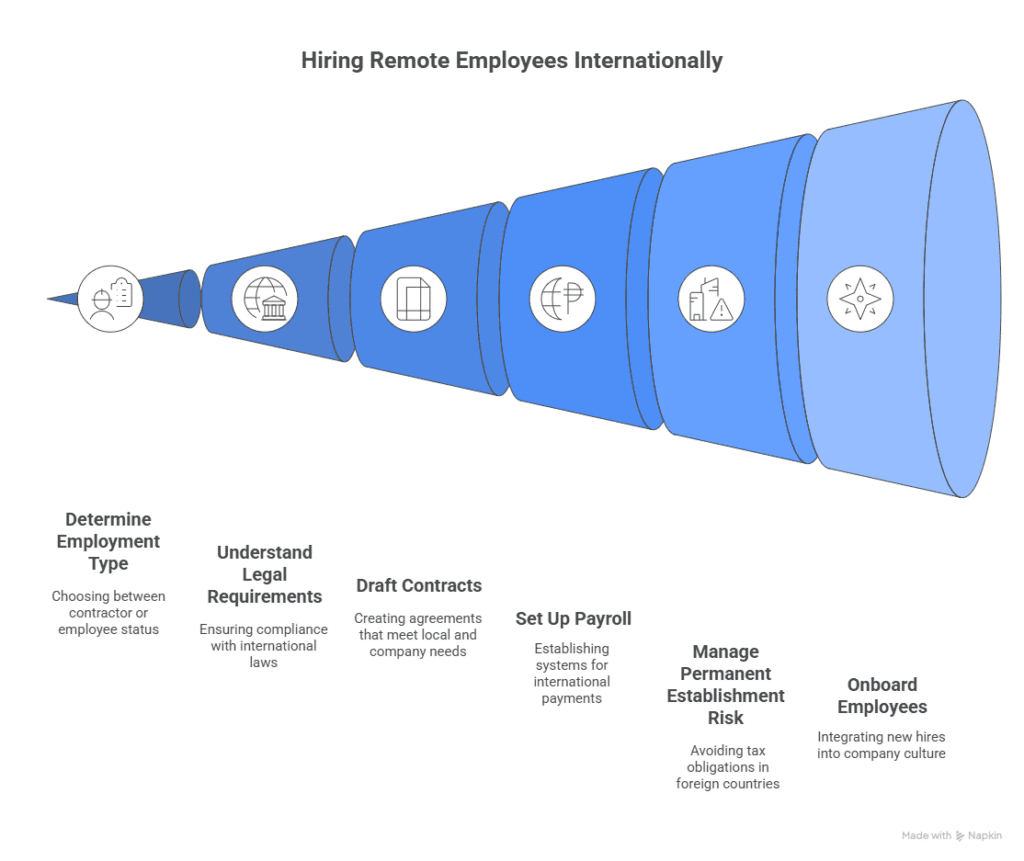Hiring international remote employees requires more than posting a job ad online. You need to understand legal compliance, contracts, cross-border payments, and how to integrate someone into your team when they’re working from another country. Business owners often ask where to start and which steps matter most to make the process smooth.
This article walks you through the essentials of hiring international remote employees. You’ll see how to handle employment classification, payroll, and onboarding while avoiding risks that could slow down your growth. By the end, you’ll know how to confidently expand your team across borders and build a remote workforce that fits your business goals.
Can a U.S. Company Hire a Foreign Employee in Another Country?
A U.S. company can hire people who live and work outside the United States. The process, however, depends on how you structure the relationship. Business owners typically choose between three main models: hiring someone as an independent contractor through a professional services agreement, employing them directly on a U.S. W-2 while they work abroad, or using a local employment arrangement through a global staffing agency or employer-of-record structure.
Each model comes with different legal, tax, and compliance implications.
How to Hire Remote Employees Across International Borders?

1. Determine Employment Type
The first decision is whether you will engage the person as an independent contractor or as an employee. Contractors provide flexibility and can be hired through a professional services agreement, but misclassification under local law is a risk if they are treated like employees in practice.
For long-term, full-time roles, many U.S. businesses prefer to use a global staffing agency or employer of record (EOR). In this model, the agency legally employs the worker in their home country while assigning them to your team, which avoids the need to open a local entity.
2. Understand Legal and Tax Requirements
Hiring international employees does not mean you suddenly owe taxes in their country. If you hire them as contractors working outside the U.S., you generally just collect a W-8 form and pay invoices; those payments are not reported on Form 1099-NEC and are not subject to U.S. withholding.
The worker handles their own local taxes. If you hire through a staffing agency or EOR, that local entity takes care of payroll and statutory requirements in the worker’s country.
From the U.S. perspective, wages paid to nonresident aliens for services performed entirely abroad are considered foreign-source income and not subject to federal income tax withholding. You also do not complete Form I-9 for workers who never perform services inside the United States.
These rules give U.S. business owners significant flexibility, though you should still be mindful of permanent establishment risk if you build a sizable presence in one country.
3. Draft International Employment Contracts
A U.S. employment contract is not enough for cross-border work. You need a professional services agreement for contractors that clearly defines deliverables, payment terms, intellectual property rights, and confidentiality.
For employees hired through a staffing agency or EOR, contracts should comply with local labor law but still reflect your expectations around salary, benefits, working hours, and termination policies.
In both cases, contracts should also address remote work expectations such as communication norms, availability across time zones, and data security.
4. Set Up Payroll and Payment Systems
Paying international remote employees requires a reliable structure. For contractors, you can pay them directly by bank transfer or through invoicing platforms, provided you have the correct W-8 documentation.
These payments are recorded as deductible business expenses in your U.S. books. For employees engaged through a staffing agency, you typically pay a single monthly invoice while the agency handles payroll and compliance locally. What matters most is consistency and documentation to avoid double taxation or compliance disputes.
5. Manage Permanent Establishment Risk
If you hire multiple people in one country or give them authority to sign contracts and generate revenue on your behalf, that country could view your business as having a permanent establishment there.
This status creates corporate tax obligations even if you do not formally register a branch. To avoid unexpected tax bills, structure your operations carefully and consider using a staffing agency or EOR that shields you from this exposure.
6. Onboard Remote Employees Effectively
International hiring is not only about paperwork.
Success depends on onboarding and cultural integration. Remote employees need clear introductions to your company values, workflows, and communication tools. By addressing cultural differences early and standardizing collaboration methods, you create a smoother experience and stronger alignment across your virtual team, whether they are nearshore in Latin America or offshore in Eastern Europe and North Africa.
7. Use Workforce Management Practices
Managing a distributed workforce requires systems that maintain consistency. Even without specialized platforms, you can create internal procedures for contracts, time-off requests, and communication.
The goal is to ensure visibility and compliance across your team, regardless of geography. Many business owners combine regular check-ins with standardized reporting to keep operations running smoothly.
8. Evaluate Costs and Strategic Benefits
Finally, compare the economics of hiring abroad against U.S. salaries. Nearshore hires in Latin America often deliver 40–70% savings while aligning closely with U.S. time zones. Offshore talent in Eastern Europe and North Africa may offer technical expertise and broader coverage across time zones.
Beyond cost, international hiring helps you scale faster, build resilience, and access skills that may be scarce in the U.S. market.

Three Options for Hiring International Workers from Another Country
Expanding your workforce across borders requires clear decisions about employment structures, compliance obligations, and long-term strategy. U.S. companies exploring how to hire international workers legally usually face three main paths: establishing a local entity, partnering with a staffing agency, or hiring contractors. Each model carries different costs, risks, and levels of control.
Establish a Legal Entity Abroad
Setting up a local legal entity gives you the ability to employ foreign workers directly under the host country’s labor laws. This option suits businesses planning long-term operations in a specific region or companies that expect to hire dozens of employees in one country.
To do this, you register a business in the target jurisdiction—such as creating an LLC or equivalent—and secure a tax identification number. Once registered, you must manage local payroll, taxes, and statutory benefits like health coverage or pension contributions.
While this option gives you the most control over hiring, it also comes with significant upfront and ongoing costs. Incorporation fees, local accounting services, and annual compliance filings can easily range from tens of thousands of dollars per year depending on the jurisdiction.
Business owners researching how to open a company overseas to hire employees often find that this approach makes sense when the operation is permanent and sizable. However, for smaller teams or early-stage expansion, it can be unnecessarily complex and resource heavy.
Partner with an International Staffing Agency
Working with a global staffing agency or employer of record (EOR) allows you to hire abroad without setting up your own entity. The agency becomes the legal employer in the worker’s country while assigning that employee to your team. From your perspective, you gain access to the talent, but the staffing partner handles contracts, payroll, taxes, and compliance with local labor laws.
This model is particularly useful when building nearshore teams in Latin America or offshore teams in Eastern Europe or North Africa, where time-zone alignment and specialized skills make cross-border hiring attractive. U.S. business owners searching for nearshore staffing agencies vs offshore agencies comparisons often find that agencies speed up onboarding, reduce compliance risk, and provide smoother workforce management.
The trade-off is cost: you pay the agency a service fee in addition to the worker’s salary. For many companies, the reduced legal risk and faster hiring cycle outweigh the expense, especially when testing a new market or scaling quickly.
Engage Independent Contractors
Hiring independent contractors abroad is the most flexible and lightweight option. Instead of employing workers directly, you sign a professional services agreement that outlines deliverables, payment terms, intellectual property rights, and confidentiality.
Payments to contractors living and working entirely outside the U.S. are generally not reported on Form 1099-NEC and are not subject to U.S. income tax withholding, provided you collect the appropriate W-8 form.
This approach minimizes your obligations because contractors handle their own local taxes and benefits. For U.S. companies searching contractor vs employee for remote hiring, the contractor model is attractive for project-based roles, pilot programs, or testing talent in a new market.
The limitation is control. Contractors typically set their own schedules and cannot be managed in the same way as employees. Misclassification is also a risk: if the relationship looks like full-time employment under local law, authorities may impose penalties.
Business owners who want ongoing stability and retention often move from contractors to staffing agency arrangements once they decide to scale.
When Is Hiring International Employees Useful?
Hiring international employees is useful when a company needs skills that are scarce locally, wants to enter new markets, or needs to operate more efficiently across time zones. The value comes from matching business needs with the strengths of global talent pools.
Access to Specialized Skills
Some regions have deep expertise in certain fields. Eastern Europe is well known for software engineering and IT security. Latin America has a growing base of bilingual professionals in marketing, design, and engineering. Businesses that cannot find the right skills at home often search abroad to close those gaps.
Entering New Markets
Employing people in the regions where you plan to expand makes international growth smoother. A U.S. business entering Latin America, for example, benefits from hiring bilingual employees who understand local culture and can communicate directly with clients. This approach supports trust and more effective service delivery.
Time Zone Coverage and Productivity
A distributed workforce can extend operating hours. Nearshore recruiting in Argentina, Colombia, or Costa Rica keeps teams in sync with U.S. schedules while lowering salary costs. Offshore hiring in Eastern Europe or North Africa adds earlier coverage, which can support customer service or continuous development cycles.
Broader Perspectives in Teams
Hiring internationally also increases diversity of thought. Employees with different cultural backgrounds contribute alternative approaches to problem-solving. In areas such as marketing, product development, or design, these perspectives can help adapt strategies for a wider range of audiences.
Reducing Workforce Risk
Depending only on one labor market makes a business vulnerable to shortages and rising wages. Hiring abroad spreads that risk. Companies with nearshore or offshore teams are less exposed to local disruptions and can scale more steadily. For startups, international hiring can also be a cost-efficient way to add capacity without overextending budgets.
Compliance Considerations
Global hiring requires the right structure. Independent contractors, staffing agency partnerships, and local employment each carry different compliance obligations. Proper documentation—such as professional service contracts and W-8 forms—helps U.S. businesses stay compliant while avoiding permanent establishment risks.
How to Find Qualified International Remote Employees
Once you know when and why to hire internationally, the next step is sourcing qualified candidates. U.S. businesses looking to build nearshore or offshore teams need clear methods to identify reliable professionals, verify skills, and ensure smooth integration into remote operations.
Define the Role and Skills Clearly
Start with a precise job description that reflects the skills, responsibilities, and working conditions of the role. For international remote employees, clarity is essential. State whether the role is contractor-based or full-time, outline required language proficiency, and highlight any time-zone availability expectations.
Employers searching for job descriptions for international remote employees should prioritize details that help filter out unqualified candidates early.
Use Global Talent Platforms and Networks
There are established online platforms where international professionals advertise their services, from freelance marketplaces to specialized job boards focused on remote work.
Beyond public platforms, many companies use international staffing agencies or recruitment partners with networks in specific regions such as Latin America, Eastern Europe, or North Africa. These agencies pre-screen candidates and provide access to talent pools that may not be visible on global job boards.
Verify Skills and Experience Thoroughly
When hiring internationally, resumes alone are not enough to confirm a candidate’s ability. Ask for work samples that demonstrate relevant experience, use technical tests where applicable, and conduct structured interviews to evaluate both skills and problem-solving.
Standardized assessments give you a consistent way to compare candidates from different regions, making it easier to identify the strongest fit for your team.
Check Language and Communication Fit
For international hiring, strong communication is often as important as technical skill. If the role requires client interaction, bilingual ability can be a decisive factor. Testing candidates with short written exercises or live discussions helps ensure they meet your team’s communication standards.
Business owners often search for how to hire bilingual employees abroad because effective language skills directly impact collaboration and customer experience.
Evaluate Reliability and Infrastructure
Remote employees must have the right setup to perform effectively. Ask about internet connectivity, backup power options, and access to necessary tools.
In many cases, nearshore staffing agencies include infrastructure checks as part of their screening process. Verifying these factors early reduces the risk of disruptions once the employee is onboarded.
Leverage Referrals and Regional Expertise
Local referrals remain one of the most reliable ways to find qualified candidates. Partnering with organizations or agencies that understand cultural expectations and labor practices in their region helps filter for professionalism and reliability. Queries like best way to recruit in Latin America or trusted networks for offshore hiring point to the growing demand for region-specific expertise.
The Benefits of Hiring Internationally
Hiring employees from outside the US offers strategic advantages for businesses aiming to scale operations and remain competitive. Expanding globally enables access to untapped talent pools, diverse perspectives, and operational efficiencies.
Worldwide Coverage
Recruiting international workers remotely creates opportunities for 24/7 business operations. A distributed workforce ensures tasks are completed across time zones without delays. For example, a team member in Eastern Europe can address client needs while U.S.-based staff rest, improving service delivery.
Global hiring also supports market expansion by embedding local expertise into your team. Hiring bilingual employees in Latin America or Asia helps bridge cultural gaps and strengthens customer relationships in those regions. Additionally, nearshore recruiting for U.S. businesses—such as sourcing talent from Central America or Colombia—provides cost-effective solutions with minimal time zone differences.
By building a remote team in different countries, companies mitigate risks tied to reliance on a single labor market. This strategy enhances resilience during economic fluctuations or domestic skill shortages. Tools like global payroll solutions for small businesses simplify compliance when managing salaries across borders.
Increased Diversity, Equity, and Inclusion (DEI)
International employee hiring fosters DEI by integrating varied cultural backgrounds into organizational decision-making processes. Diverse teams bring unique problem-solving approaches that drive innovation—a critical factor in industries such as technology and marketing.
Understanding cultural differences in global hiring is essential for creating inclusive work environments where all employees feel valued. For instance, localized hiring practices ensure recruitment aligns with regional norms while promoting fairness during interviews and assessments.
Cross-border talent acquisition also addresses equity challenges by providing opportunities to underrepresented groups worldwide. Partnering with international staffing agencies or using an Employer of Record (EOR) simplifies this process while ensuring compliance with labor laws for international hiring.
Unique Challenges for U.S. Employers Hiring Internationally
Hiring international remote employees creates real advantages, but it also introduces challenges that U.S. businesses need to plan for. The main issues involve compliance, payments, cultural alignment, scheduling, and contract structure.
Legal Requirements and Compliance Risks
When hiring someone who remains abroad, a U.S. company does not usually owe local employment taxes. The key is classification. If the worker is engaged as an independent contractor, you should have a professional services agreement in place and collect the appropriate W-8 form to document foreign status. Payments for services performed entirely outside the U.S. are generally not reported on Form 1099-NEC, but keeping proper records is essential.
If the role functions like full-time employment, misclassification risks increase. Local authorities may argue that the worker is entitled to employee protections, even if you are paying them as a contractor.
Another concern is permanent establishment: if you create what looks like a branch office in one country, that government may decide you have a taxable presence there. This is unlikely with a single hire, but it becomes more relevant if you build larger teams concentrated in one market.
Payroll and Payments Across Borders
Some U.S. companies pay international contractors directly by wire transfer or online payment platforms. This approach is simple but requires careful documentation to avoid compliance issues. Contractors are responsible for their own local taxes, and your responsibility is to treat the expense correctly in your U.S. accounting.
For long-term employees, many businesses prefer to work through a staffing agency or employer of record (EOR). In this model, the agency handles payroll, benefits, and local compliance while you direct the day-to-day work. This reduces administrative complexity and limits exposure to foreign labor obligations.
Cultural Alignment in Remote Teams
Cultural differences can affect collaboration and productivity. Nearshore hires in Latin America often align more closely with U.S. business culture and communication styles, which makes integration smoother.
Language skills are another advantage in the region, as many professionals are bilingual and able to work with both U.S. colleagues and local clients. Taking time during onboarding to explain company culture and communication expectations helps minimize misunderstandings in cross-border teams.
Time Zone Coordination
Coordinating across time zones is another operational challenge. Nearshore teams in countries like Mexico, Colombia, or Costa Rica share much of the same business day with U.S. companies, allowing for real-time collaboration. Offshore teams in Eastern Europe provide earlier coverage, which can be valuable for support or development cycles, but may require flexible scheduling.
Contracts and Documentation
Strong documentation protects both sides. Contractors should have professional services agreements that clearly define scope of work, payment terms, confidentiality, and ownership of intellectual property.
Employees hired through a staffing agency or EOR will have localized contracts that meet local legal standards, but you should ensure those agreements also reflect your company’s requirements for performance, reporting, and data security.
The Next Step in Global Hiring
Hiring internationally is no longer limited to large corporations. U.S. businesses of every size now have access to talent pools across Latin America, Eastern Europe, and North Africa.
This article has walked through the process step by step — from choosing the right employment structure, to understanding compliance, to identifying when global hiring delivers the most value. You’ve seen how international recruitment can fill skill gaps, extend time zone coverage, strengthen market entry strategies, and build resilience against labor shortages. At the same time, you’ve also learned about the challenges: permanent establishment risk, cultural alignment, payroll complexity, and legal compliance.
For many business owners, the opportunity is clear, but so is the complexity. That’s where Scale Army comes in. As a global staffing agency focused on nearshore and offshore recruitment, we connect U.S. companies with vetted professionals across Latin America, Eastern Europe, and North Africa. We manage the legal, contractual, and operational details so you can focus on building and leading your team.
If you’re ready to add qualified international remote employees to your business, schedule a call with Scale Army today. In just 15 minutes, we’ll map out how you can build a cost-effective, compliant, and scalable workforce abroad.
Book a Strategy Call with Scale Army





